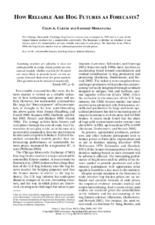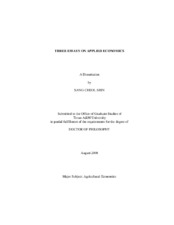| dc.contributor.advisor | McCarl, Bruce A. | |
| dc.creator | Shin, Sang-Cheol | |
| dc.date.accessioned | 2010-01-16T02:28:40Z | |
| dc.date.available | 2010-01-16T02:28:40Z | |
| dc.date.created | 2008-08 | |
| dc.date.issued | 2010-01-16 | |
| dc.identifier.uri | https://hdl.handle.net/1969.1/ETD-TAMU-2008-08-43 | |
| dc.description.abstract | In this dissertation three essays were presented. In the first two essays we measure the
consumer welfare changes caused by U.S. meat price changes. In the third essay the
dynamic structure of international gasoline prices using the time series methodology is
investigated.
In chapter II, we investigate the U.S. consumer behavior on meat consumption
depending on a linear expenditure system (LES), and then we simulate the welfare
effects of a set of price changes on the U.S. meat consumption. The simulation results
show that the amount of consumer welfare change for each meat is not same across the
meats under the same percentage change of price. The simulation results also show that
when all the prices are doubled the total amount of CV reaches almost the same amount
of current total quarterly expenditures for the three meats.
In chapter III, we apply the compensating variation (CV) approach for the
measurement of consumer welfare losses associated with beef price changes. We applied
the long-run cointegrating relationship in vector error correction model (VECM) to
estimate the Marshallian demand function. Apparently, the use of long-run cointegration
in VECM in deriving the direct Marshallian demand function to measure the consumer welfare change is the first attempt in the literature. This is one of the contributions of the
study. The simulation results show that the amount of consumer welfare change for beef
is compatible with the one derived from LES methodology.
In chapter IV, an empirical framework to summarize the interdependence of four
international gasoline markets (New York, U.S. Gulf Coast, Rotterdam and Singapore) is
presented. For that purpose, we employ a structural VECM and directed acyclic graphs
(DAGs). To solve the identification problem in structural VECM, we apply DAGs
derived from contemporaneous VECM innovations.
The impulse response functions show that the time period in which a shock in a
market affects the other market is very short. Forecast error variance decompositions
(FEVD) shows that in all markets, except the U.S. Gulf Coast market, current and past
shocks in their own market explained the most of the volatility in their own market in the
Short-run. | en |
| dc.format.mimetype | application/pdf | |
| dc.language.iso | en_US | |
| dc.subject | Consumer Welfare | en |
| dc.subject | Compensating Variation | en |
| dc.subject | Vector Error Correction Model | en |
| dc.subject | Demand Theory, Time Series | en |
| dc.title | THREE ESSAYS ON APPLIED ECONOMICS | en |
| dc.type | Book | en |
| dc.type | Thesis | en |
| thesis.degree.department | Agricultural Economics | en |
| thesis.degree.discipline | Agricultural Economics | en |
| thesis.degree.grantor | Texas A&M University | en |
| thesis.degree.name | Doctor of Philosophy | en |
| thesis.degree.level | Doctoral | en |
| dc.contributor.committeeMember | Jin, Yanhong | |
| dc.contributor.committeeMember | Bessler, David A. and Elbakidze, Levan | |
| dc.contributor.committeeMember | Ward, Michael P. | |
| dc.type.genre | Electronic Dissertation | en |



